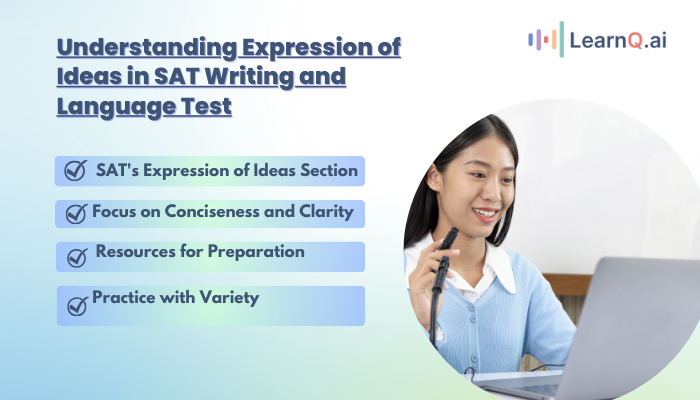The SAT Writing and Language Test assesses your proficiency in editing written passages to improve their clarity, coherence, and effectiveness. Central to this exam is the “Expression of Ideas” section. Here it tests your ability to enhance text through meticulous attention to style, organization, and tone.
Mastering the expression of ideas section of the SAT demands a keen understanding of how to develop ideas effectively and adjust the voice of a text to meet specific rhetorical purposes.
LearnQ.ai is Powered by VEGA AI—Is your Institute Next?
Give students a Duolingo-style test-prep platform with Shopify-level customization for tutors and institutes.
In this blog, we will explore essential question types and offer strategic advice to help you excel in this section. We will also recommend top resources to bolster your preparation, aiming to maximize your performance and elevate your overall SAT score.
What is the Expression of Ideas?
Expression of Ideas questions focus on the bigger picture. Instead of dealing with individual grammar rules, they test your ability to:
- Develop Ideas: This step evaluates your ability to effectively organize and thoughtfully expand upon the content, aiming to communicate messages that are not only clear but also impactful. It challenges you to think critically about how each piece of information fits together to form a coherent narrative.
- Organize Information: This process involves meticulously checking if the ideas and information are logically structured within the passage to enhance both understanding and flow. A well-organized text allows readers to easily follow your thought process, making the communication of complex ideas more straightforward.
- Effective Language Use: Here, you must carefully ensure that your word choices are not only appropriate for the context but also serve to clarify and enrich the text. Effective language use enhances readability and engagement by precisely conveying your intended message and adding depth to your expressions.
These questions typically ask you to make improvements on a broader level. You may be required to add, remove, or reorder sentences, change phrasing for clarity, or enhance the passage’s tone and style.
Key Question Types in the SAT’s Expression of Ideas Section
In the Expression of Ideas section of the SAT, you will come across several distinct types of questions, each designed to evaluate different facets of your capability to enhance both the effectiveness and the readability of a passage:
1. Purpose Questions
These questions are designed to assess your comprehension of the main goal or objective of a passage. Specifically, they require you to identify or adjust text elements to ensure they are in alignment with the intended purpose of the text.
Example: You may encounter a question that presents a specific sentence and asks whether it supports the passage’s argument or whether it should be removed to enhance clarity and streamline the narrative.
2. Addition/Deletion Questions
This category demands that you critically analyze whether adding or removing specific pieces of information could improve the clarity and impact of the passage.
Example: You might be asked to evaluate whether including a particular detail could strengthen an argument or if omitting it might better maintain the focus and coherence of the passage.
3. Revision Questions
These questions concentrate on improving the clarity and impact of sentences by improving their phrasing or structural elements.
Example: This involves selecting a revision that more effectively conveys the significance of a point or that simplifies complex syntax to improve understanding and retention.
4. Consistency and Style Questions
These questions test your ability to maintain or improve the tone and expressive qualities of a passage. You will need to adeptly adjust the language to match the target audience or to better serve the purpose of the text.
Example: A question may require you to alter the tone from casual to formal or ensure that the expression remains consistent throughout the document.
Each of these question types is integral in testing your editorial skills and your ability to think critically about written text, making them essential components of the SAT’s Expression of Ideas section.
Now that we’ve explored the various types of questions within the ‘Expression of Ideas’ section let’s shift our focus to strategies for excelling in this area and achieving a higher score on the SAT.
Also read: SAT Punctuation Rules: Tips for Commas, Dashes and Colons
Strategies for Mastering Expression of Ideas for SAT
Here are detailed strategies that can help you refine your skills and prepare thoroughly:
Understand the Context
Ensure you grasp the passage’s overarching theme. This will make your edits and suggestions relevant and impactful.
Focus on Conciseness and Clarity
Focus on removing any unnecessary words and simplifying your sentences to make your points more direct and impactful. The goal is to convey ideas in the simplest possible way without sacrificing depth or meaning.
Use Transition Words Appropriately
Transitional words and phrases guide readers smoothly through your arguments. They bridge ideas and improve the logical flow of the text. Use transitions like “however,” “furthermore,” and “therefore” to link sentences and paragraphs, making your content clear and easy to follow.
Enhance your Digital SAT study routine with AI-driven insights and personalized practice tests.
Practice with Variety
Gain exposure to different writing styles and topics, such as narrative and expository. This broadens your editing skills and prepares you for the SAT’s text variety. Challenge yourself with materials of varying complexity to sharpen your adaptability and analytical skills.
Know Grammar Rules
A strong grasp of grammar is crucial. To make accurate edits, focus on understanding key grammatical principles. To avoid basic mistakes, pay special attention to common SAT issues like subject-verb agreement, tense consistency, and comma usage.
Review Effective Writing Techniques
Study well-written texts to understand what makes writing effective. Please consider how skilled writers develop their ideas, structure their texts, and use expressive elements. Analyzing these techniques can provide insights into how to enhance the persuasiveness, readability, and engagement of your own revisions.
Take Practice Tests
Regularly taking SAT practice tests under timed conditions helps familiarize you with the test’s format and pacing. This practice also allows you to apply the editing strategies you’ve learned in a simulated test environment, which can help reduce anxiety and improve your test-day performance.
Peer Review and Feedback
Feedback from peers or instructors is invaluable. It provides new perspectives on your editing choices and helps identify areas for improvement. Constructive criticism allows you to refine your approach and strengthen your writing skills through continual learning and adaptation.
Now that we’ve covered strategies to enhance your SAT Writing skills let’s explore some essential resources that will further support your preparation for the exam.
Enhance your Digital SAT study routine with AI-driven insights and personalized practice tests.
Essential Resources for Preparation
To excel on the SAT Writing and Language Test, consider leveraging these highly effective preparation resources:
- LearnQ: Utilizes innovative learning methods and customized study paths, catering to your individual pace and learning style for optimal understanding.
- Official SAT Practice on College Board: The College Board provides practice tests with explanations directly from the test makers, offering a realistic feel of the actual exam.
- Khan Academy SAT Prep: Delivers personalized practice that identifies and targets your weak areas, helping you strengthen specific skills efficiently.
- The Princeton Review SAT Prep: Offers detailed practice materials and strategic insights, covering all aspects of the SAT to ensure comprehensive preparation.
- Magoosh SAT Prep: Features a wide range of practice questions, video lessons, and timed tests designed to enhance your understanding and improve your test-taking speed.
These resources can significantly boost your readiness for the expression of ideas SAT, equipping you with the tools needed to achieve a high score.
Also read: How to get started with LearnQ.ai for FREE?
LearnQ.ai is powered by VEGA AI—Is your institute next?
Offer students a Duolingo-style test-prep platform with Shopify-level customization for tutors and institutes.






Conclusion
Excelling in the SAT Writing and Language Test’s Expression of Ideas SAT section is vital to boosting your overall score. This component evaluates your ability to refine texts for enhanced clarity and effectiveness. To succeed, you need a deep understanding of the text’s main ideas, sharp attention to detail, and robust command of language mechanics.
For focused practice, get started with LearnQ, which tailors your study path to your unique needs. Also, consider joining the SAT student community on Discord for additional support and insights.











